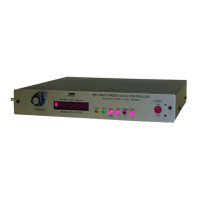MFJ-1278B MULTI-MODE ADVANCED OPERATION
The above method of calling CQ is NOT appropriate for use on one of the crowded calling
frequencies. There, everyone is already tuned more or less to the same frequency. To call
CQ on one of the calling frequencies do the following:
1. Find the "center" of the channel by tuning the radio so that the tuning indicator is
centered on most of the signals.
2. Make sure your "UNProto" field is set to CQ.
3. Enter converse mode.
4. Occasionally strike a <CR> (2 a minute or so if DCD lets your packets clear the channel
that fast) and wait for the MFJ-1278B to get an opportunity to squeeze the packet into
the activity on the channel. Allow some time after your packet has been sent for
someone to attempt a connect with you and then send another CQ packet by typing a
<CR>.
5. If (when) someone connects, immediately negotiate a QSY to a clear channel. Then call
him on the new frequency as outlined above (in the clear channel CQ procedure) for a
scheduled contact.
Please use care in selecting the QSO frequency so as to avoid unnecessary interference to
other amateur services. As in all amateur communication modes, it is polite to listen before
you transmit!
Monitoring a propagation beacon frequency will not necessarily be sufficient to reveal this
activity to you. It is best to make a note of which INDICATED frequencies you should avoid
so that your radiated packet spectrum (from F(emission) above) will not get within several
hundred Hz of a propagation beacon.
HF packet operation is fundamentally different than other modes of operation in 1 major
respect. If you are on a clear channel, talking to only 1 other station, there will be long
periods of silence. People using other modes and tuning around looking for a clear frequency
to use may be fooled by the silence. Don't assume that an interfering station who shows up
considerably after you have begun using the frequency is interfering on purpose, he may
honestly not have been aware of your QSO in progress. For this reason, it is a good idea to
keep the flow of the conversation going so that the lapses aren't too long. It can also be
advantageous to have more than one packet QSO on the channel but if more than a very few
get on the same channel, the throughput falls off very fast as the likelihood that all stations
are properly configured and have working DCD circuits is small.

